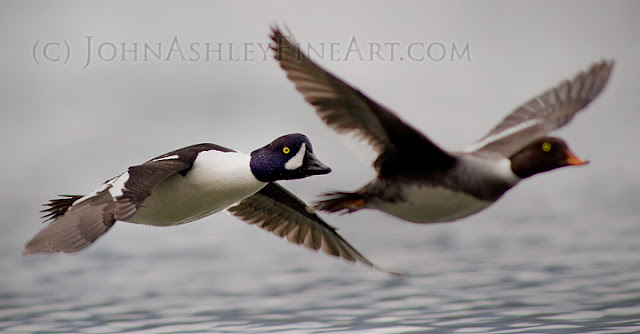Sir John Barrow was a handsome, travellin' man.
Born in England in 1764, Barrow joined a whaling expedition to Greenland at age 16, served in Britian's first embassy in China, and mapped the interior of South Africa. As a government official, he promoted the search for a "North-West Passage" across the Canadian Arctic, authored the official report we now call "The Mutiny on the Bounty," and was credited with helping defeat Napoleon's navy.
Barrow's achievements brought him many laurels. Barrow Point in Alaska and Barrow Straight in Canada were named in his honor, as was the sea-going duck species we now call the Barrow's Goldeneye.
The male Barrow's Goldeneye is also a handsome traveller. He not only migrates in the spring and fall, like the females, but he makes an early summer expedition as well.
The species exists in two far-flung North American populations that do not mix, on either end of the fabled "North-West Passage." In the east, there's a small population of about 4,000 that breeds in Iceland and winters along the Atlantic coast of northeast Canada. On the western side of the continent, there's a much larger population estimated at somewhere between 150,000 and 200,000 ducks. These western ducks winter along the Pacific coast from southern Alaska to Washington state, and breed between central Alaska and western Montana.
Goldeneyes most often nest in natural tree cavities and old woodpecker holes, flying straight into the opening without slowing down. (You'll rub your eyes in disbelief when you see it happen.) Older females often reuse the same cavity each year. Younger females arrive a little later, and they often spend the first couple of summers "nest prospecting" or checking out the tree cavities around the lake to see which ones are occupied and successful.
Six to twelve large, olive-green eggs are laid, one every other day, and incubated for 30 days in the down-lined nest. On average, the eggs total more than half of the female's weight, and she'll loose another 12% of her body mass during incubation.
In early summer, about 7-10 days after the female begins incubation, the paired male leaves his breeding pond and migrates to a distant molting location. (One banded male flew more than 700 miles in less than two days to reach his moulting site.) The males are flightless for about a month while growing new feathers, and they'll remain on the molting areas into the fall. Back at the breeding pond, the female molts while tending her brood.
 Goldeneye chicks are born brown-eyed and precocial. The iris turns from brown to blue to blue-green and then to green-yellow. (Adult males feature the namesake golden irides.) They can swim immediately and dive underwater for food 1-2 days after hatching.
Goldeneye chicks are born brown-eyed and precocial. The iris turns from brown to blue to blue-green and then to green-yellow. (Adult males feature the namesake golden irides.) They can swim immediately and dive underwater for food 1-2 days after hatching.Goldeneyes eat mostly insect larvae (dragonfly, mayfly), crustaceans (crayfish) and a some aquatic plants, but they do not eat fish. By measuring the caloric value of these items, biologist have estimated that a goldeneye chick needs to catch and eat at least 175 food items each day, while an older adult needs to catch eat an astonishing 1,500 items per day.
Older females gain an advantage by nesting earlier. These females with young set up new brood territories where they may act aggressive or adoptive towards goldeneye broods that show up later. If she encounters a younger mom, or chicks that are a different age than hers, she'll chase them off or even kill the other chicks. But if she encounters chicks that are about the same age as her own, she'll often steal the brood of a younger mom by force, or adopt abandoned chicks.
Successful goldeneye moms abandon their young after 5-6 weeks, when they move to fall staging areas. The youngsters learn to fly 2-3 weeks later, when most of them will wander off to nearby lakes. During the fall, most goldeneyes will remain inland until the lakes start freezing over, and they often form small flocks that may include their smaller cousins, the Buffleheads.
Goldeneyes start migrating to the coast in early November, where they'll spend the winter feasting on blue mussels and periwinkles. Some, however, will winter at inland locations. An estimated 2,000 Barrow's Goldeneyes winter in northwestern Montana, and groups of goldeneyes also winter in the magma-heated waters of Yellowstone Park.
Established pairs will reunite on the coast to spend the winter together, with some (about one-third) even defending winter territories -- the only waterfowl to do so. Younger birds will court in small groups and eventually form new pairs.
When spring returns, the Barrow's will travel again and the expeditions will start anew.
Behind the lens: Photographed with a hand-held, manual focus, whale-of-a-lens. Nikon D700, 500mm f4 lens with 1.4 teleconverter (my favorite for birds, can you tell?).
Behind the man: Sir John Burrows was also a founding member of the Royal Geographical Society, which supported the explorations of Charles Darwin, David Livingstone and Sir Edmond Hillary, among others.
Behind the man: Sir John Burrows was also a founding member of the Royal Geographical Society, which supported the explorations of Charles Darwin, David Livingstone and Sir Edmond Hillary, among others.



